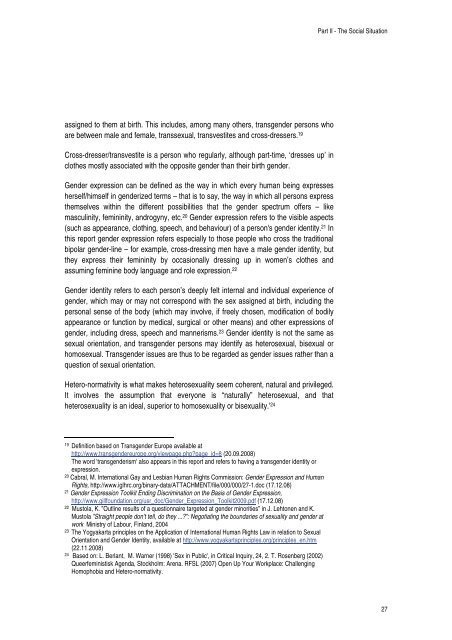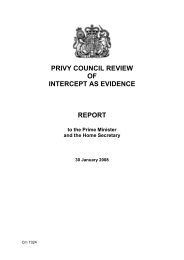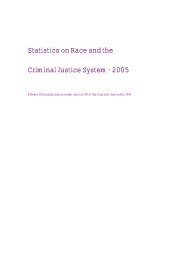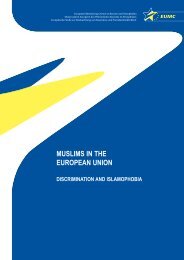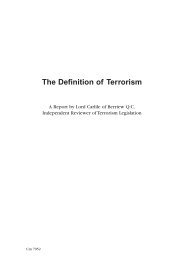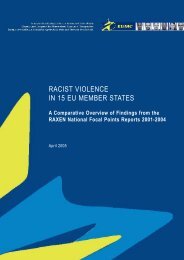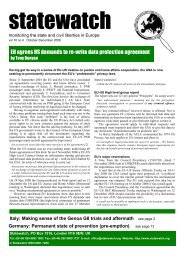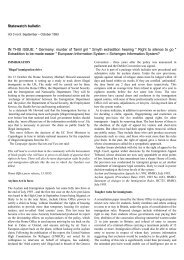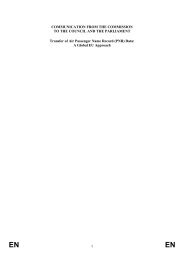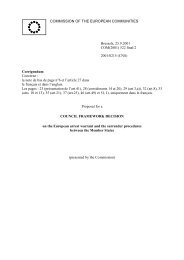Homophobia and Discrimination on
Homophobia and Discrimination on
Homophobia and Discrimination on
You also want an ePaper? Increase the reach of your titles
YUMPU automatically turns print PDFs into web optimized ePapers that Google loves.
assigned to them at birth. This includes, am<strong>on</strong>g many others, transgender pers<strong>on</strong>s who<br />
are between male <str<strong>on</strong>g>and</str<strong>on</strong>g> female, transsexual, transvestites <str<strong>on</strong>g>and</str<strong>on</strong>g> cross-dressers. 19<br />
Cross-dresser/transvestite is a pers<strong>on</strong> who regularly, although part-time, ‘dresses up’ in<br />
clothes mostly associated with the opposite gender than their birth gender.<br />
Gender expressi<strong>on</strong> can be defined as the way in which every human being expresses<br />
herself/himself in genderized terms – that is to say, the way in which all pers<strong>on</strong>s express<br />
themselves within the different possibilities that the gender spectrum offers – like<br />
masculinity, femininity, <str<strong>on</strong>g>and</str<strong>on</strong>g>rogyny, etc. 20 Gender expressi<strong>on</strong> refers to the visible aspects<br />
(such as appearance, clothing, speech, <str<strong>on</strong>g>and</str<strong>on</strong>g> behaviour) of a pers<strong>on</strong>'s gender identity. 21 In<br />
this report gender expressi<strong>on</strong> refers especially to those people who cross the traditi<strong>on</strong>al<br />
bipolar gender-line – for example, cross-dressing men have a male gender identity, but<br />
they express their femininity by occasi<strong>on</strong>ally dressing up in women’s clothes <str<strong>on</strong>g>and</str<strong>on</strong>g><br />
assuming feminine body language <str<strong>on</strong>g>and</str<strong>on</strong>g> role expressi<strong>on</strong>. 22<br />
Gender identity refers to each pers<strong>on</strong>’s deeply felt internal <str<strong>on</strong>g>and</str<strong>on</strong>g> individual experience of<br />
gender, which may or may not corresp<strong>on</strong>d with the sex assigned at birth, including the<br />
pers<strong>on</strong>al sense of the body (which may involve, if freely chosen, modificati<strong>on</strong> of bodily<br />
appearance or functi<strong>on</strong> by medical, surgical or other means) <str<strong>on</strong>g>and</str<strong>on</strong>g> other expressi<strong>on</strong>s of<br />
gender, including dress, speech <str<strong>on</strong>g>and</str<strong>on</strong>g> mannerisms. 23 Gender identity is not the same as<br />
sexual orientati<strong>on</strong>, <str<strong>on</strong>g>and</str<strong>on</strong>g> transgender pers<strong>on</strong>s may identify as heterosexual, bisexual or<br />
homosexual. Transgender issues are thus to be regarded as gender issues rather than a<br />
questi<strong>on</strong> of sexual orientati<strong>on</strong>.<br />
Hetero-normativity is what makes heterosexuality seem coherent, natural <str<strong>on</strong>g>and</str<strong>on</strong>g> privileged.<br />
It involves the assumpti<strong>on</strong> that every<strong>on</strong>e is “naturally” heterosexual, <str<strong>on</strong>g>and</str<strong>on</strong>g> that<br />
heterosexuality is an ideal, superior to homosexuality or bisexuality.' 24<br />
19 Definiti<strong>on</strong> based <strong>on</strong> Transgender Europe available at<br />
http://www.transgendereurope.org/viewpage.php?page_id=8 (20.09.2008)<br />
The word 'transgenderism' also appears in this report <str<strong>on</strong>g>and</str<strong>on</strong>g> refers to having a transgender identity or<br />
expressi<strong>on</strong>.<br />
20 Cabral, M. Internati<strong>on</strong>al Gay <str<strong>on</strong>g>and</str<strong>on</strong>g> Lesbian Human Rights Commissi<strong>on</strong>: Gender Expressi<strong>on</strong> <str<strong>on</strong>g>and</str<strong>on</strong>g> Human<br />
Rights, http://www.iglhrc.org/binary-data/ATTACHMENT/file/000/000/27-1.doc (17.12.08)<br />
21 Gender Expressi<strong>on</strong> Toolkit Ending <str<strong>on</strong>g>Discriminati<strong>on</strong></str<strong>on</strong>g> <strong>on</strong> the Basis of Gender Expressi<strong>on</strong>,<br />
http://www.gillfoundati<strong>on</strong>.org/usr_doc/Gender_Expressi<strong>on</strong>_Toolkit2009.pdf (17.12.08)<br />
22 Mustola, K. ”Outline results of a questi<strong>on</strong>naire targeted at gender minorities” in J. Leht<strong>on</strong>en <str<strong>on</strong>g>and</str<strong>on</strong>g> K.<br />
Mustola ”Straight people d<strong>on</strong>’t tell, do they ...?”: Negotiating the boundaries of sexuality <str<strong>on</strong>g>and</str<strong>on</strong>g> gender at<br />
work Ministry of Labour, Finl<str<strong>on</strong>g>and</str<strong>on</strong>g>, 2004<br />
23 The Yogyakarta principles <strong>on</strong> the Applicati<strong>on</strong> of Internati<strong>on</strong>al Human Rights Law in relati<strong>on</strong> to Sexual<br />
Orientati<strong>on</strong> <str<strong>on</strong>g>and</str<strong>on</strong>g> Gender Identity, available at http://www.yogyakartaprinciples.org/principles_en.htm<br />
(22.11.2008)<br />
24 Based <strong>on</strong>: L. Berlant, M. Warner (1998) 'Sex in Public', in Critical Inquiry, 24, 2. T. Rosenberg (2002)<br />
Queerfeministisk Agenda, Stockholm: Arena. RFSL (2007) Open Up Your Workplace: Challenging<br />
<str<strong>on</strong>g>Homophobia</str<strong>on</strong>g> <str<strong>on</strong>g>and</str<strong>on</strong>g> Hetero-normativity.<br />
Part II - The Social Situati<strong>on</strong><br />
27


